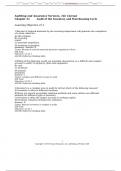Exam (elaborations)
Chapter 21 Audit of the Inventory and Warehousing Cycle
- Institution
- Auditing And Assurance Services 14th Edition
Chapter 21 Audit of the Inventory and Warehousing Cycle Auditing and Assurance Services 14th Edition Test Bank
[Show more]



